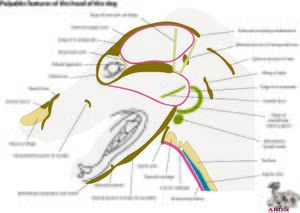Difference between revisions of "Superficial Anatomy - Anatomy & Physiology"
Jump to navigation
Jump to search
| Line 1: | Line 1: | ||
{{unfinished}} | {{unfinished}} | ||
| − | Superficial anatomy of the head of the dog | + | '''Superficial anatomy of the head of the dog''' |
[[File:Headpalp.jpg|thumb|Landmarks, Superficial anatomy of the head]] | [[File:Headpalp.jpg|thumb|Landmarks, Superficial anatomy of the head]] | ||
Revision as of 01:51, 26 December 2010
| This article is still under construction. |
Superficial anatomy of the head of the dog
Dorsal neck:
- Locate the spinous process of the axis, and cranially and laterally to this, the transverse processes of the atlas on each side. Determine the extent of rotation in the atlantoaxial joint with reference to these landmarks.
- Locate the external occipital protuberance. Determine the degree of flexion and extension possible in the occipitoatlantal joint with reference to this and the transverse processes of the atlas. These three landmarks are used to determine the placing of a needle for cerebrospinal; fluid collection from the cerebellomedullary cistern.
Dorsal head
- Palpate the external occipital protuberance and rostrally along the medial occipital crest medially between the muscle masses of m temporalis on each side.
- Locate the mastoid process of the petrous temporal bone near the external auditory meatus. At this level, the zygomatic arch leads rostrally to the orbit. The rim of the orbit is bony, expect caudally where it is completed by the orbital ligament. This ligament, however feels hard and indistinguishable from bone.
- Over the bony surface of the maxilla, palpate the infraorbital vessels and nerve, and caudally to where they emerge from the infraorbital foramen.
- The rim of the osseous nasal opening is formed by the incisive bone laterally and the nasal bone dorsally. The nasal cartilages form the sides of the nasal vestibule.
Ventral neck
- Palpate the tracheal rings by pushing aside the covering ventrally of m sternohyoideus.
- Cranially palpate the arch of the cricoid cartilage, then to the ventrally protruding part of the thyroid cartilage.
- Rostral to this is the basihyoid bone. Pressing this should promote a swalowing movement during which the hyoid arch is protracted.
Ventral head
- Lateral to this are the large muscle masses of mm masseter and pterygoid fusing ventral to the body of the mandible. The parotid duct crosses the lateral surface of m masseter.
- Locate the mandibular salivary gland and mandibular lymph nodes medial to M pterygoideus.
- Rostral to the rostral edge of m masseter, the bony ventral border of the mandible is palpable. The mandibles meet medially at a mandibular notch ventrally. Caudal to this, locate the mental foramen.
